Bluntly, the consumer display market hasn’t been the most exciting place for video enthusiasts since the discontinuation of plasma display panels (PDPs) in late 2013. Although they weren’t suitable for use in every kind of viewing environment, the last few years of that display technology’s life consisted of healthy competition between Samsung, who showed plasma increasing interest in its later years, and Panasonic, who were long its biggest proponents. The end result was affordable TVs of extremely high quality, with improvements to contrast performance and motion quality coming each year.
By contrast, LED LCD has remained mostly stagnant, with the most visible development being the introduction of curved televisions (which ironically enough, with LCD, has actually damaged the contrast performance and screen uniformity). The increased use of local dimming technology has been of some comfort, although it comes at a hefty premium. Then there’s the introduction of High Dynamic Range (HDR) content, which plays directly into LCD’s strength of producing bright images and hits luminance highs that plasma could never hope to achieve… if you have the source material encoded in the HDR format, that is. (Fortunately, OLED displays can deliver HDR pictures, too).
All eyes are on OLED to fill the gap for a truly high-quality television that can produce a convincing shade of black in a dark viewing environment (or a bright one), but except for a single Samsung product, LG has had the OLED TV marketplace entirely to itself (at least in the UK and Europe). As we would expect for a manufacturer single-handedly shepherding a new category of display to market, there have been some issues along the way – although these haven’t dampened most reviewers’ enthusiasm for their contrast performance, which as we’d expect from any OLED, has been incredible from day one.
But as we head into 2016, things are looking up. First, LG’s own OLED TVs are getting better. That’s probably attributable to the fact that LG Display is achieving better and better yields in OLED panel manufacturing, meaning that more OLED panels coming off the assembly line can be built into televisions instead of being scrapped. And that’s probably also why Panasonic has now finally been able to launch its own OLED TV: the Japanese company is of course using OLED panel modules from LG Display (there’s nobody else currently manufacturing TV-sized OLED panels at this time of writing), but is bringing its own panel driving and other video processing to the table.
| Macro photo of CZ952’s subpixels confirming WRGB OLED panel from LG Display |
This means that an entirely separate group of engineers has now had the opportunity to build a TV out of the same core element. It’s a similar story to the early days of LCD, which saw (to name one example) Sony reliant on Samsung for LCD panel modules. At the time, buying a Sony TV was the way to see a Samsung LCD panel at its best, due to the Japanese brand’s then-superior video processing (the gap eventually disappeared completely, and both manufacturers’ processing these days is superb).
Rumoured for some time, the Panasonic CZ950 OLED – sold as the Viera CZ952 in the UK – was finally outed launched towards the end of summer 2015, marking the first announcement of a self-emitting display from Panasonic since the introduction of its final plasmas in early 2013. Currently exclusive to the European market, the 65-inch Viera TX-65CZ952B/ 65CZ950 is priced at around £8000 in the UK, and features an 3840×2160 UHD (ultra high-definition) resolution panel, driven by Panasonic’s proprietary “4K Studio Master Processor”. Most excitingly, that affords the TX65CZ952 extensive look-up table technology which Panasonic claim allows it to better manage colour accuracy and near-black detail reproduction compared to competing OLED TVs (sure enough, these have been problematic on the competition’s OLED product). The CZ952/ CZ950 is also HDR-capable, if not upon delivery, then by means of a firmware update, though we’re still waiting for the new Ultra HD Blu-ray format to see HDR at full quality without being compromised by internet limitations.
Reassuringly, the Panasonic TX65CZ952B has also gained THX’s certification, making it the first 4K Ultra HD OLED TV to do so. It’s been far, far too long, so let’s dim the lights, sit back, and take a good hard look at a self-emissive Panasonic TV.
Panasonic’s OLED product is curved, whereas LG has begun selling flat panels. That alone causes grumbles from video enthusiasts, although it may actually be a selling point for the high-end luxury designer market that Panasonic has positioned the TX-65CZ952 towards. When we compared the LG FLOLED beside the Panasonic at the 2015 UK TV shootout event in Leeds, we found that the curve was subtle enough that we soon forgot its presence (that’s not to say that we didn’t notice it, just that it didn’t stand out). However, some of the attendees mentioned that they preferred the competing LG OLED model due to its flat form factor on principle. As always, let us know your thoughts in the comments.
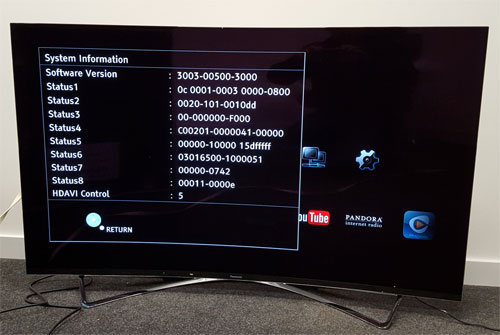
LG Display’s introduction of flat OLED displays is a welcome move, however, and as for the future of curved TVs, LG Electronics’ Nandhu Nandhakumar, when interviewed by AVSForum’s Scott Wilkinson at CE Week 2015 in New York, stated that he felt “the novelty has worn out” for the non-flat form factor (but noted that LGD plans to produce both types of panel going forward). We have to wonder if the presence of the curve on the TX-65CZ952B is a deliberate design choice on Panasonic’s part, or if it’s simply what LG Display chose to make available to outside manufacturers. Personally, we wouldn’t choose a curved display over a flat one, but it also wouldn’t put us off a product, all else being equal. At least, unlike on an LCD device, there appear to be no other image quality side-effects introduced by the curved screen.
Curve aside, there is very little to differentiate TV styling these days, given how small the bezels are. Case in point, the most notable aspect of the Panasonic CZ952 is probably the backplate, the inclusion of which is to ensure that it remains a showpiece from any angle. It’s made from a synthetic suede-like material called Alcantara. While HDTVTest reviews are in-depth, we did not do any tests on the composition or the quality of the Alcantara, but we are sure that it is luxurious (it was certainly the ritziest-looking thing in our test room). All in all, the 65CZ952B looks as sleek as you’d expect, and the build quality is excellent.
There’s nothing really OLED-specific about the Panasonic TX65CZ952B’s picture quality setup menus, except of course for the fact that the main control over screen light output is called [Luminance level] rather than “Backlight”, because OLED panels do not use backlights (thank goodness). Everything else is as you’d expect from Panasonic: there are extensive calibration controls, which act as a front-end for the in-depth 3D Look-up Table (LUT) that Panasonic has trumpeted. There are also various image processing options – [MPEG Remaster] and [Noise Reduction] being the most obvious, for reducing the painfulness of low quality sources. There’s no shortage of picture preset modes; we used [Professional1] and [Professional2] (which can be relabelled as [isf Day] and [isf Night] respectively by an ISF-certified calibrator) for our setup.
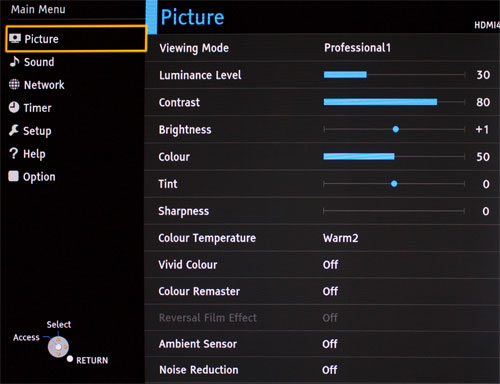
The other most notable menu controls are for the [1080p Pure Direct] (or [4K Pure Direct]) and [1080p pixel by 4pixels]. The former avoids limiting the chroma bandwidth, resulting in finer reproduction of small coloured details, by bypassing some video processing steps – things like the noise reduction systems, which we’d never want to use with a high quality Blu-ray source anyway. The second option, [1080p pixel by 4pixels] disables the spatial interpolation, that is, the upscaling process which calculates new pixels to fill the UHD resolution panel. Instead, it makes up the difference by filling the additional pixels with duplicates of the surrounding ones. We don’t recommend most users enable it since it since it causes the image to appear pixelated, but you might find it interesting to flip on and off so you can see exactly what the TX-65CZ952’s scaler is doing to produce UHD content from a lower resolution source, and gain a new-found appreciation for the art of image scaler design in the process.
Panasonic supplies the CZ950/ CZ952 with a beautifully designed “brushed steel” silver remote, which doesn’t use any motion sensing technology, just good old buttons (although an additional touchpad remote is also available). The tried-and-tested design makes zipping around the menus nice and fast. In some regions, LG’s OLED televisions are supplied only with the gyroscope (think Nintendo Wii) Magic Remote, which is a novel way to interact with a TV, but makes fully calibrating it fairly tedious when combined with those TVs’ menu design. Having buttons make the calibration process considerably faster, even though the menus do lag a little and are far from the zippiest we’ve seen on a Panasonic display.
The Panasonic TX-65CZ952B calibrates almost effortlessly, which is a huge relief. We measured it using a Klein K10-A colorimeter profiled against a reference-grade Konica Minolta CS2000, as well as SpectraCal’s CalMAN Ultimate software, and found that the native greyscale tracking of the panel was red-deficient, so it produced images with a greeny-blue tint relative to a completely accurate reference. Dialling this out took about a few minutes of back-and-forthing with the standard 2-point greyscale controls, and we then used the 10-point controls to ensure the colour of grey remained consistent at all brightness levels. Once this was done, we used the very stable 10-point Gamma controls to fine-tune the light output of each of the areas of the brightness range. Colour barely needed any adjustment, but we did so anyway for completeness.
This is in stark opposition to LG’s OLED TVs, where calibrators have to gingerly massage the controls and hope that no artefacts are being introduced as a result. LG OLEDs can now be configured to produce a good image, but their calibration controls do not always work correctly. Those actually have a 20-point greyscale adjustment menu, but Panasonic’s 10-point controls are superior (even if they don’t sound so on paper) because they work correctly without introducing strange contouring artefacts into the picture. On the Panasonic TX65CZ952, we didn’t experience any of the posterisation/ contouring or colour accuracy issues we’ve seen on the competing OLED TVs.
Gamma at the high end varied a little between measurements. When we measured linearly – that is, by stepping through the levels in order (70%, 75%, 80%, 85% etc)., the high end gamma was darker by a small amount. On the other hand, when we called up the patterns out of sequence, they hit their 2.4 target. This behaviour is probably some kind of screen saver functionality, and will have no real visible effect on content – we mention it only for completeness.
One interesting point in OLED TV menus is the inclusion of both [Luminance level] and [Contrast], the latter of which is a control over the white level of the video signal. On an LED LCD TV, the equivalent [Backlight] control would affect the intensity of the actual LED lights (the physical light-emitting component), whereas [Contrast] would alter the digital values of the pixels being displayed by the LCD module at the video processing stage. In other words, on an LCD display, the light output and contrast performance are the result of two different properties.
Of course, an OLED TV is self-illuminating and does not use a backlight, which may cause some to question the need for having two controls. [Luminance level] seems to adjust the relative voltage values being fed to the OLED display itself, whereas [Contrast], as on most televisions, controls the digital white level during video processing. This is interesting, because many Panasonic plasmas – also self-emitting by nature – tied the panel luminance control and the white level control into one menu option called [Contrast] (at least in some of their picture modes and worldwide variants).
On a self-emitting display, we imagine that this will only change the stage at which the values are adjusted, because there is no longer a separate light source. Therefore, we were curious as to whether a different calibration strategy would even make a difference to the final picture. Our initial calibration involved setting [Contrast] so as not to crush out or discolour any white details, and then using the [Luminance level] slider to adjust the light output of the panel – as usual, we adjusted this to 120 cd/m2 (35 fL), suitable for a darkened viewing environment.
We then calibrated [Professional2] using our alternative idea: by keeping the [Panel Luminance] fixed at its highest setting (100) and using only the [Contrast] control to dim the then ultra-bright picture down to the level required for comfortable dark-room viewing. The first thing we did was inspect a 10-bit greyscale gradient ramp pattern, which has a smooth transition from black at the left of the screen, to white at the right. We then moved back and forth between the two modes, looking for discontinuities in the smooth tone (banding), and could see very little difference. We also ran some intensive colour tests to see if one of the strategies resulted in better colour accuracy, particularly at low luminance levels, but this also revealed no significant differences. Accordingly, we stayed with the former calibration method simply because there was no reason to take the road less travelled.
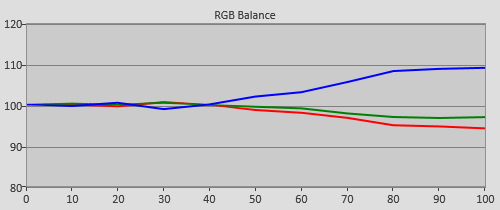 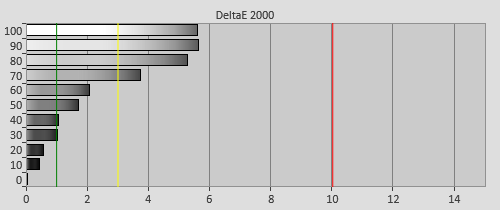 |
| Pre-calibration [True Cinema] RGB tracking and delta errors (dEs) |
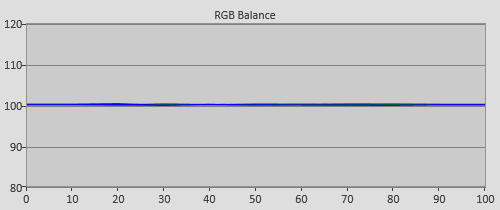 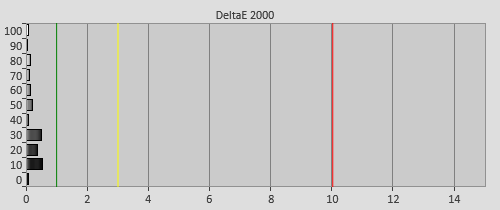 |
| Post-calibration RGB tracking and dEs in [Professional] mode |
![Pre-calibrated Gamma tracking in [True Cinema] mode](https://www.hdtvtest.co.uk/news/wp-content/uploads/2018/04/uhdtv_Panasonic-TX65CZ952B_pre-gamma.png) | ![Post-calibrated Gamma tracking in [Professional] mode](https://www.hdtvtest.co.uk/news/wp-content/uploads/2018/04/uhdtv_Panasonic-TX65CZ952B_post-gamma.png) |
| Pre-calibration gamma tracking (2.44) | Post-calibration gamma tracking (2.38) |
![Post-calibration Colour saturation tracking in [Professional] mode](https://www.hdtvtest.co.uk/news/wp-content/uploads/2018/04/uhdtv_Panasonic-TX65CZ952B_post-strack.jpg) |
| Post-calibration colour saturation tracking |
![Post-calibration colour errors in [Professional] mode](https://www.hdtvtest.co.uk/news/wp-content/uploads/2018/04/uhdtv_Panasonic-TX65CZ952B_post-strack-de.png) |
| Post-calibration colour errors (<3 not appreciable to the eye) |
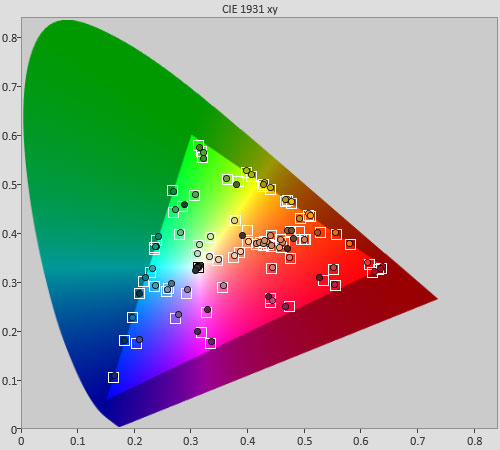 |
| Post-calibration Colour Checker SG test |
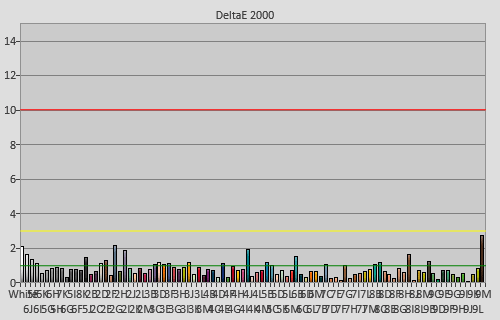 |
| Post-calibration Colour Checker SG errors (<3 not appreciable to the eye) |
| Dead pixels | None |
| Screen uniformity | Vertical banding in low-APL scenes, much improved from previous generations |
| Overscanning on HDMI | Defeatable |
| Blacker than black | Passed |
| Calibrated black level (black screen) | 0 cd/m2 |
| Calibrated black level (4×4 ANSI) | 0 cd/m2 |
| Black level retention | Perfect, no floating blacks noted |
| Primary chromaticity | Excellent |
| Scaling | Excellent |
| Video mode deinterlacing | Effective jaggies reduction |
| Film mode deinterlacing | Passed 3:2/480i but failed 2:2/576i with film mode on |
| Viewing angle | Near-perfect, although blue tint in highlights noted from off-axis |
| Motion resolution | 650 with [IFC] engaged; 300 otherwise |
| Digital noise reduction | Optional; effective when engaged |
| Sharpness | Defeatable edge enhancement |
| Luma/Chroma bandwidth (2D Blu-ray) | Full (in [Pure Direct] mode) |
| 1080p/24 capability | No judder, perfect 24fps reproduction |
| Measured panel refresh rate | 120Hz |
| Measured DCI-P3 coverage | 86% |
| Leo Bodnar input lag tester | 74ms in [Game] mode |
| Full 4:4:4 reproduction (PC) | Yes, in [Pure Direct] mode |
| Default [Normal] mode | 214 watts* |
| Calibrated [Professional] mode | 145 watts |
| Standby | <1 watt |
_*Note: Out of the box, [Ambient Sensor] was switched on by default in the [Normal] picture preset.
_
In brief, Panasonic’s TX65CZ952B produced the best overall picture quality that we have seen on a television. There are still some issues, but we feel that its other strengths are sufficient enough for us not to focus on them for too long.
Although this is not the first time we’ve sat down with an Ultra HD OLED panel, it’s the first time we’ve done so without really questioning the colour or luminance accuracy of what we’ve been seeing. We sat down with the Blu-ray Disc of Skyfall, and at the risk of embarrassing ourselves when we re-read this in ten years, we could hardly think of any way in which the picture we were seeing could be bettered. While we love film, we’re huge fans of the wide dynamic range and overall look of the Arri Alexa digital cinema camera (in the right hands, naturally) used to shoot this particular Bond outing. It’s an incredibly well-shot film which has been brought to BD with all due skill. Previous OLED TVs have struggled to correctly light or colour some of the darker scenes. In particular, the scene where Judi Dench’s character arrives home to her London townhouse has strong yellowy-orange light, to the extent that even a small colour error can produce a very sickly-looking result. Additionally, in the sequence where Bond is preparing to re-join MI5, the blue clothing he’s wearing, on some previous OLED attempts, was desaturated to the point of looking nearly black. None of these colour errors were present on the Panasonic CZ952.
The most consistent difference we found when comparing the Viera 65CZ952B to last-gen Panasonic plasmas was in the reproduction of certain blue shades. On the plasmas, these appeared “navy blue”, whereas on the OLED, they appeared more of a “teal” colour. Confusingly, both of these displays measured as being very accurate, even in the most exhaustive colour tests. We know that OLED has posed new challenges for post-production facilities, so even though our Klein K10A colorimeter has been profiled against a reference-grade Konica Minolta CS2000, we still can’t rule out some kind of measurement limitation. Having said that, we’ve seen more extreme cases of cyan shades skewing towards a greenish teal on LG OLED televisions too. This is something we hope to investigate in more depth, but we had no reason to question the TX-65CZ952B’s colours when we viewed it in isolation – nothing stuck out as being obviously wrong, which again, has not been the case with every OLED TV we’ve assessed. There is also the point that experienced Hollywood colourist Mike Sowa has endorsed Panasonic’s OLED – a beneficial promotional opportunity for both parties, but not one that an esteemed industry professional would enter into before thoroughly vetting the display.
During the entire review process, we never witnessed the TX65CZ952’s blacks “floating”. Blacks stayed rock solid, which is in contrast to the LG OLED TVs. During the November 2015 shootout in Leeds, we used an Oppo Blu-ray player to drive the displays, and occasionally spotted the black background of the the main menu screen appearing as a very dark grey shade on the LG EF950V.
Panasonic’s CZ952 also excels above the competition thanks to its ability to render a clean greyscale. Again, at the Leeds event, we were able to compare a calibrated TX-65CZ952B with a calibrated LG 65EF950V. During dark scenes, the LG had difficulty in rendering pixels with their correct brightness levels, which could exaggerate or reveal previously invisible artefacts lurking in dark areas. During video compression, darker areas are typically quantised (detail-thinned) more aggressively, under the assumption that they will not be seen and are therefore a waste of valuable bits. A TV which inadvertently reveals them can therefore reveal the compression artefacts in these areas. The Panasonic TX65CZ952B appears to be completely free of this problem.
One of the most challenging areas for OLED so far has been screen uniformity. If you’d like to know why that is, read the section below. If you want the quick answer, Panasonic’s TX-65CZ952 produces the best screen uniformity of an Ultra-HD OLED panel to date. We checked out the recently released UK Blu-ray of The Gift, which is unusual in that it almost never fully reaches black. The suspenseful camera movements through the couple’s home at night have their shadows set to a dark grey, and sure enough, during these scenes we could detect some subtle vertical columns of uneven brightness. A plasma would show these same scenes with a good amount of constantly-moving noise, which we felt was a little harder to detect (since it’s moving rather than constantly stuck in place, we mentally tune it out a little easier), and also possibly a “scrolling scanlines” effect. However, you would have to be sat close to the screen in order to see either of those, whereas luminance discontinuities spread over a wide area are visible regardless of viewing distance. There’s room for improvement here, but the TX-65CZ952B has the best low-level uniformity we’ve seen on a UHD OLED display, and we were never seriously troubled when watching content, even if we were aware of its imperfections.
Screen uniformity has turned out to be a difficult area for OLED displays. Plasma typically performed well in this area, although it also didn’t have a perfect track record (for example, the 50-series Panasonic PDPs often exhibited non-uniform grey streaks on the right edge of the panel, and the 30-series had an issue where white fields could appear with green impurities). And, LED LCD typically has average or poor screen uniformity, which is the result of impurities between the various layers in the LCD module, or in the light guide plate used to disperse the output of the LEDs across the panel surface.
With OLED, the initial “Full HD” 1080p models had decent near-black uniformity, but this went downhill after the move to Ultra HD resolution. The first UHD OLED TVs showed visible columns of uneven uniformity during dark scenes, and more problematic still was the vignetting effect where the extreme left and right edges of the panel would appear visibly darker than the rest of the picture. As we noted above, the Panasonic CZ952 does not fully do away with the vertical streaks, but unlike LG’s current OLED TVs, the streaks do not have hard edges, which makes them much less visible. Also, the vignetting effect has been reduced to the extent that we never saw it during actual content, and only just in test signals, which is remarkable.
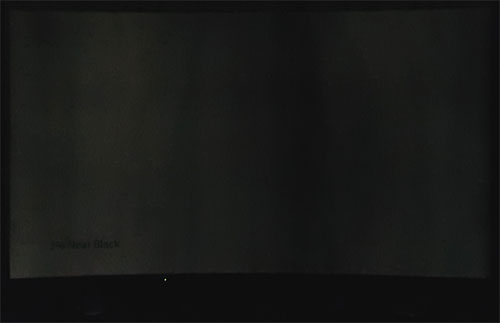
Before we explain why this occurs, let’s discuss our findings from the Panasonic TX65CZ952B in more detail. After cutting out the lights in a pitch-black room, we displayed full-screen fields of just above black (from the AVSHD test disc). In our calibrated mode, we found that the 1% above black pattern was not discernible against black (we made sure that our eyes were sufficiently adjusted to the darkness of the room and that the Black Level on the display was correctly set). 2% above black appeared, albeit with some vertical streaking, although our eyes had to be fully acclimatised to the pitch-black room in order to detect this. By the time we reached 3% above black, there were only mild vertical “pillars” of non-uniformity visible. There was also a small horizontal “wrinkle” at the very top of the panel. Later, when we checked the same signals out again, the uniformity was a little worse, and we could see some circular vignetting patterns. Given what we have seen and described in relation to other Ultra HD OLED panels, the performance of the Panasonic, while imperfect, is a considerable improvement.
Our original assumption was that we would be left feeling that the dark-scene uniformity of the plasma displays was still superior to the OLED. However, we do need to consider the fact that the shades of black we’re seeing imperfections in are ones that no plasma or LCD could ever produce, anyway. Were we looking at a PDP, these just-above-black barely visible tones would be rendered in a less impactful shade of grey, and also blanketed in dithering noise and, depending on the panel drive mode, also the “scrolling scanline” effect. Our conclusion of this is that, while the very low-level uniformity on OLED may be worse, it is still in a class of its own in terms of black-level depth, and other display types had various other impairments in these areas.
However, this way of thinking did not allow us to see past the uniformity errors on previous OLEDs. These were severe enough, and visible during dark scenes, to the extent that our enthusiasm was tempered. It’s only now that the errors have been controlled and reduced to this extent that we can begin to see past them. What’s most important is how the uniformity appears during actual content, and what the viewer’s perception is during dark film scenes, which we’ve discussed previously.
So, why has uniformity turned out to be such a challenge for OLED? Analysis of patents filed by various companies (often surprisingly far back, such as in the early 2000s) is quite revealing. The most relevant of these is surely US#8988329B2, because it was filed by LG Display:
…TFT characteristics such as driving TFT threshold voltage (Vth) and process tolerance factors (e.g., mobility, parasitic capacitance, and channel width/length) are non-uniform among pixels due to process tolerances. For this reason, non-uniformity of luminance may occur in the AMOLED display device. To solve this problem, a data compensation method is employed. […]
The characteristics of the driving TFT may be measured through sensing of amounts of current flowing through the corresponding pixel at different voltages. For an AMOLED display device having an increased size, however, it is more difficult to rapidly measure amounts of current flowing through a number of pixels. [Also] there is a difficulty in achieving rapid sensing because the current sensing time is delayed due to parasitic capacitors present in parallel on the power line to achieve increased resolution.
To summarise: OLEDs do not have inherently good uniformity, so periodically, the electrical current flowing through the pixels must be measured and offset to produce a picture with uniform light distribution. Consumer OLED TVs are not the only video devices to employ such a mechanism; professional LCD monitors used in post-production facilities feature uniformity correction too (something we’ve long requested manufacturers to add on consumer LCD models). The panel measurement and offsetting process takes longer on larger-sized panels, and also on panels with increased resolution (there are many more pixels to measure). This explains our prior observation of the screen uniformity of OLED displays worsening with the move to UHD resolution.
We know that on the Panasonic OLED TV, the panel measurement process runs approximately every three hours. Viewing is not interrupted, which is why we say “approximately” (the TV is not going to switch itself off for self-improvement just before we find out who Luke Skywalker’s father is). It only runs when the TV is switched into standby mode after a certain number of viewing hours have accumulated. The Panasonic TX-65CZ952B’s user manual (page 20) tells us that reading and offsetting the pixels takes approximately 20 minutes, and the front LED will flash orange during the process. While the process is running, it can be interrupted at any time simply by taking the TV out of standby mode (we can only imagine how annoying it would be if the viewer was prevented from watching their TV).
The difference in the quality of uniformity therefore depends on the quality of the detection and the counter-measure that is applied, as well as the quality of the panel component itself. Panasonic’s is the best we’ve seen.
OLED’s few remaining uniformity issues are far more visible at low luminance levels, which is why we’ve been discussing just-above-black regions. This makes sense to us for a number of reasons. First, our visual system has evolved in a way which makes it far more able to detect minute brightness changes in dark areas, and relatively poor at detecting similar amounts of change in bright ones. Second, given that correcting the uniformity errors relies on voltage offsets, and that producing low luminance from the panel calls for low voltage, an incredibly precise level of adjustment must be necessary to control the barely-lit pixels.
One last word on OLED panel uniformity, and we should disclose now that this is Olympic-grade pixel peeping: all OLED televisions we’ve analysed have featured a very subtle static random dither pattern. In other words, if you stare closely enough at one in a dark room, you’ll be able to see a slight “speckling” on a flat image. Dithering is normally employed on displays to approximate shades that the panel cannot natively show (most obviously on a plasma display, although that dither was moving). However, this is not the case here: the Panasonic CZ952 has a fully 10-bit panel. The “speckling” effect may be the result of small lingering non-uniformity at the single pixel level – or, it may be there on purpose in an attempt to conceal the other non-uniformities.
We still have some questions, however. First of all, why do we have predominantly vertical columns? Second, if the obstacle is time, that is, performing the measurement process quickly enough so as to still be effective without the user interrupting it, why not simply schedule the process to happen overnight when the user is asleep? Perhaps CE companies do not want to inconvenience the user or give the perception that the TV is a complicated product just to achieve a final level of perfection that very few people (us, and our target audience) would appreciate?
In terms of white-field uniformity, both the Panasonic TX65CZ952B samples we received had a more prominent blue tint visible on the extreme right of the screen. Outside of test patterns, we didn’t see it, but the potential for it to appear during content does obviously exist.
This might come as a surprise, but reviews of really great displays don’t take too long to write. Just put on a great looking Blu-ray Disc, sit back, admire, and describe. Such is the case with the Panasonic TX-65CZ952B. We deliberately pulled out the US Blu-ray release of Spirited Away, since 2D animation, while obviously not lifelike, is fantastic at revealing display errors. During the dark “procession of the spirits” sequence, previous OLED TVs have shown severe dark shading errors on the far left and far right of the panel. Impressively, no uniformity errors stuck out on the CZ952 at all during this scene, even the ones we previously described at length.
In other cases, uniformity issues were detectable. The recent release of The Gift is an interesting case: its night time scenes often do not reach zero black. It’s these dark grey moments that reveal uniformity issues on nearly any currently available television, and indeed during the slow nighttime camera pans through the couple’s home, some streaks were visible. The same was true of the “Swamp bottom” scenes on the Spirited Away BD, but we felt that they were reduced to a level where they wouldn’t be a deal-breaker, given the many other strengths. We ran the CZ950 in parallel with a final-generation Panasonic plasma TV, and although the OLED uniformity is still a notch behind PDP, the 65CZ952 revealed intricate low-light details that were hidden behind dithering noise on the plasma.
We also took a look at the remastered version of Gladiator, the Colosseum sequences of which are a good test for natural (albeit slightly saturated) sunlit scenes. We were absolutely delighted with what we saw – as we’d expect from Panasonic, when properly configured, the TX65CZ952B didn’t partake in any whimsical revisionism, and simply produced the picture as is. The natural 35mm film grain texture shone through without appearing smeared or sticky, the colours appeared rich and vibrant, and when viewed in a dark room, the 2.35:1 letterbox bars completely disappeared, thanks to the OLED’s ability to shut these pixels off and to control the minimum luminance level without “floating blacks”.
One other observation we noted relates to light output. In spite of us calibrating the peak white output to 120 cd/m2 as usual, the Panasonic CZ952 looked brighter than other displays we’d set to a similar level, thanks to the zero black level. During dark film scenes, the amazing contrast performance of OLED TV causes our irises to fully open, and for our visual system to attempt to see as well as possible in the darkness. That means that, when a bright daylight scene appears immediately afterwards, it can be quite dazzling (in a good way). In this way, the perceived brightness of the OLED can actually be brighter, despite producing the same output.
Since we’re on the subject, a plasma display of this size would likely only just be able to reach this light output level, and while an LCD TV can be (comparatively) effortlessly lit up like a Christmas tree, it would come at the expense of further lightening the already unconvincing blacks. On OLED, blacks stay put at true zero.
Overcompressed SD TV broadcasts on a 65in UHD television are never going to look great, but at least they don’t look any worse than they did on a Full HD 1080p display. Panasonic’s MPEG Noise Filter is quite effective at blurring out the mosaic/tiling and mosquito noise effects that become even more visible with low bitrate MPEG-2 broadcasts on a large, high-resolution panel. However, there is only so much lipstick you can apply to a pig: with sources of this quality, it’s a bit late for trying to preserve film grain (for movies broadcast on TV), so we engaged the MPEG NR and Temporal NR features at their highest settings in an attempt to clean things up. Post-filtering is an inexact art, and we had no complaint about the quality of Panasonic’s method.
The TX-65CZ952’s standard-def handling leaves room for improvement in the area of film mode detection. Confusingly, the [Film Cadence Mode] setting has On, Off, and Auto settings. “Off” presumably treats all content as video and has no film-specific processing at all, but we’re not sure why there would be any need for separate “On” and “Auto” controls. Additionally, we sometimes noticed the Viera CZ952 cutting down the frame rate of high-motion video content, as if it was mis-detecting the footage as film content (the most obvious way to tell is to watch the headline ticker at the bottom of a rolling news channel).
Although OLED displays have very fast pixel switching and therefore feature no motion smearing caused by the response time of the display elements, Panasonic’s TX-65CZ952B, like LG’s OLED televisions, is 100% a sample-and-hold display. Unlike Samsung’s OLED and LCD products, and indeed even some of Panasonic’s LCDs, there is no dark picture insertion mode to increase motion resolution. This puzzles us, because in theory, the ultra-fast pixel response time of OLED should allow for the pixels to be set to black for a small amount of time.
Sony’s OLED broadcast monitors, instead of blanking the entire screen, disrupt their native sample-and-hold nature by featuring a “rolling scan”. In these displays, a chunk of rows of the panel are set to black, meaning that every line on the OLED is not illuminated at once. Of course, this causes some flicker and decreases the light output of the display. Unlike a plasma which had to flash its pixels in various different configurations at ultra-high speed in order to draw a single 60, 96 or 100 Hz video frame and could therefore insert a very short, controlled burst of black, current OLED displays refresh at 120Hz, which is apparently too low a refresh rate for flicker-free, controlled dark frame insertion.?
In other words, the motion performance of the TX65CZ952B has a lot in common with LCD: on the old FPD Benchmark test, it resolves 300 lines with its motion interpolation features off, and about 650 with [Intelligent Frame Creation] enabled. We were not left wanting by the real-world performance, but that’s largely because our main use is for 24p film, which is too low a frame rate to really push any display. With high motion sports content, plasma may still have the edge, although its very crisp motion was not entirely perfect (to be succinct, LCD and OLED motion has the tendency to blur, whereas plasma motion has the tendency to become noisy).
In the future, we’d love to see an alternative option for motion rendering on OLEDs.
The Panasonic 65CZ952’s fastest input lag is a hefty 74 ms, which makes it unsuitable for all but the most sedate gaming use. We tried all possible configurations, including the Game mode and also [1080p Pure Direct], but rest assured, the sluggish 74ms figure is the fastest possible.
When new displays appear, the internal architecture is typically more complicated than on established, streamlined products. We imagine that the intensive image processing present in the Viera CZ950/ CZ952 is the culprit for the high level of gaming lag, and hope that in time, Panasonic OLED TVs will become ubiquitous and will be powered by simpler, faster silicon. Until that time, there is still no OLED display that is ideal for video game or other fast interactive use. If this is your top priority, some of the faster LCDs, or if you can still find them, plasma televisions, will be a better choice.
While previous OLED TVs have showed promise, Panasonic’s TX-65CZ952 represents a turning point, because it’s the first time that we’ve been able to appreciate a big-screen Ultra HD OLED display without being discouraged by colour accuracy issues, greyscale contouring artefacts, or obvious luminance non-uniformity errors in dark scenes. Panasonic’s video processing and panel driver combined with LG Display’s OLED is the combination we’ve been waiting for, and while the CZ952/ CZ950 is not a perfect product, it still produces the overall best image we’ve seen from a TV.
The TX65CZ952B introduces some sorely needed choice, not to mention some sorely needed competition (if only in part), into the OLED TV market. Its black level and contrast ratio are phenomenally good, but this combination of strengths is the absolute minimum we expect from an OLED display, and is not enough to produce a great picture on its own. The Panasonic TX-65CZ952B excels beyond this baseline and produces an extremely lifelike, three-dimensional, accurate picture thanks to its excellent image accuracy. While there is potential room for improvement in screen uniformity, the CZ952 is extremely effective at suppressing any issues, to the extent that they do not significantly detract from the many other strengths. Even if that wasn’t the case, the uniformity is now far better than LED LCD.
Our main point of contention is the 65CZ952B’s high level of input lag, which makes it unsuitable for fast-paced video games. We’d also like to see alternative motion compensation processing to combat the motion blur that is inherent to sample-and-hold displays.
Is the picture quality of the CZ950 OLED sufficient to replace the best plasma displays? Yes. On paper, OLED should have been superior from day one owed to its infinite contrast ratio, but initial issues dampened our enthusiasm and forced us to wait for a worthy successor. The Viera TX-65CZ952 marks the point where OLED has pulled ahead.
From the point of view of video enthusiasts, Panasonic naturally face competition from LG, whose efforts to commercialise and mass-produce OLED television we couldn’t be more thankful for. Their earlier OLED attempts stumbled in several ways, but this is what we would expect from any fledgling technology (it isn’t easy being first), and they have been steadily improving their own OLED TVs. When we compared them side-by-side in November, Panasonic’s implementation came out on top, but we could also see the huge improvements that have recently been made to this technology in general. LG are naturally able to sell OLED TVs at a markedly lower price, and we eagerly look forward to seeing what they have for us in 2016.
Either way, if you want the best Ultra HD TV around, Panasonic’s TX-65CZ952B is it.
